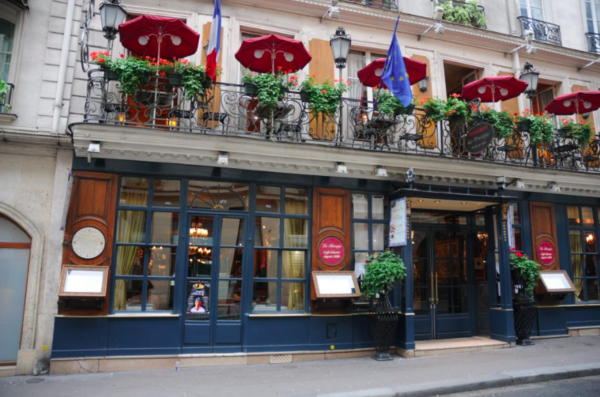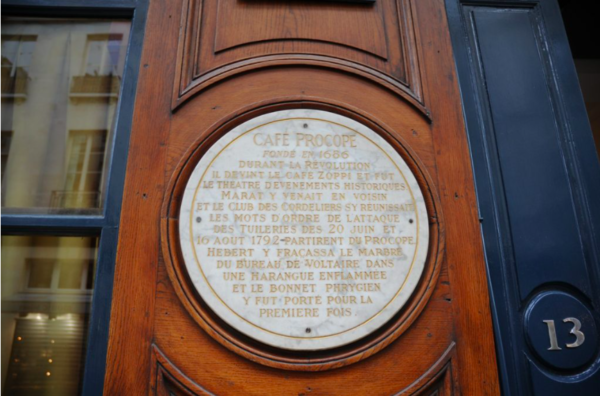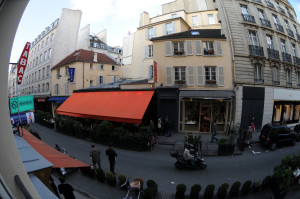The point of our coming back to Paris is to do research for my new series of books. The books are walking tours of Paris based on specific historical periods, events, or themes. The real reason to come back to Paris is to drink espresso in the little cups while sitting for hours outside at a bistro watching complete strangers go by (trust me, they’re trying to stare you down as well). By the time you’re ready to take that second sip, the coffee is cold. But since you’ve paid the premium price to sit outside, you take your time and don’t let on that the coffee is cold. I guess it really doesn’t matter since there are only two sips in the cup to begin with.
I don’t think they would ever allow the coffee to get cold at the Café Le Procope. Voltaire would sit there for hours drinking his daily 100 cups of coffee (if served in normal espresso cups, then it’s really only equal to three Starbuck’s Venti cups) while writing or holding audience with anyone who would listen to him.

Nearby would sit the revolutionaries such as Danton, Desmoulins, Robespierre, and those other wonderful chaps who would ultimately die on the scaffold. Revolutions have a tendency to eat their own and the French Revolution was a great example.
Other visitors included the Americans: Benjamin Franklin, Thomas Paine, and Thomas Jefferson. When Benjamin Franklin died shortly after returning to the United States from France, the Café Le Procope was draped in black.
The Café Le Procope was founded in 1686 and several years later, moved to the location it still occupies in the Cour de Commerce. It was a time when Paris had just “discovered” coffee and it was the rage to sit around drinking it while arguing over some inane points such as feudalism commonly known in France as the “Ancien Regime.”
Back then, Paris was made up of small passageways or “Cours” and while some have survived Haussmann’s destruction, the Cour de Commerce is certainly one of the most interesting passageways if not the most historic. It was here that Jean Paul Marat printed his daily newsletters that incited the citizens to rebel (regardless of whether the news was truthful or not). Dr. Guillotine and Tobias Schmidt developed and tested the guillotine in the basement of a building on this small street (when the sheep’s blood ran too high down the center of the street, they were asked to leave). Danton and Desmoulins lived here on the Cour de Commerce. Marat’s house was just steps away from the original entrance to the passageway.
If you were standing on that small street in 1200, you’d be standing in the moat surrounding the city wall of Philippe-Augustus. On one side of the street you would be outside the city and on the other side, you would be in the city. Looking through the front glass of a restaurant in the passageway, you can see one of the surviving towers from the wall.

When we invited Dan to join us (our nephew and a professional photographer), I told him that he would be learning a bunch of really useless information. I’m happy to say that I’ve upheld my end of the bargain.
Do we have a lot of stories? Of course we do. I’m looking forward to sharing these with you. Please continue to visit our blog.
Thanks so much for following my blog and my little journey through this incredibly interesting process of writing a book and then getting the bloody thing published.
-Stew
Please note that I do not and will not take compensation from individuals or companies I mention or promote in my blog.
Share this:
Follow Stew:
Find Stew’s books on Amazon and iBooks.
Please note that we do not and will not take compensation from individuals or companies mentioned or promoted in the blogs.
Walks Through History
Copyright © 2013 Stew Ross


